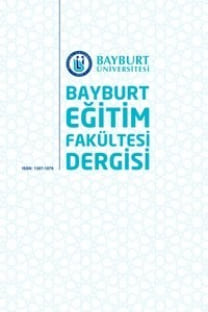Tinkercad ile STEM Eğitiminde Ortaokul Öğrencilerin Robotik ve Kodlamaya Yönelik Tutumları
STEM Eğitimi, Robotik ve Kodlama, Tinkercad
Attitudes of Secondary School Students towards Robotics And Coding In STEM Education With Tinkercad
STEM Education, Robotics and Coding, Tinkercad,
___
- Datteri, E. (2013). Predicting the long-term effects of human-robot interaction: A reflection on responsibility in medical robotics. Science and engineering ethics, 19, 139-160.
- De Silva, L., & Ekanayake, H. (2008, December). Behavior-based robotics and the reactive paradigm a survey. In 2008 11th International Conference on Computer and Information Technology (pp. 36-43). IEEE.
- Eguchi, A. (2014). Educational robotics for promoting 21st century skills. Journal of Automation Mobile Robotics and Intelligent Systems, 8(1), 5-11.
- Genç, Z. & Karakuş, S. (2011). Learning by design: Using Scratch in the design of educational computer games. 5.International Computer and Instructional Technologies, Fırat University, 981-987. Elazığ
- Göksoy, S., and Yılmaz, İ. (2018) Information technology teachers and students' views on robotics and coding course. Düzce University Journal of Social Sciences Institute, 8(1), 178-196.
- Gülbahar, Y., & Kalelioğlu, F. (2018). Information technologies and computer science: Curriculum update process. Journal of National Education, 47(217), 5-23.
- Güleryüz, (2020). The effect of 3D printer and robotic coding applications on 21st century learner skills of prospective teachers, STEM awareness and STEM teacher self-efficacy.(Tez No: 655527)[ Doctorate Thesis, Atatürk University- Erzurum].Yüksek öğretim Kurulu Başkanlığı Tez Merkezi.
- Güleryüz, H., & Dilber, R. (2021). STEM activities made with robotic coding; the effect on awareness of teacher candidates regarding its use in science lessons. İnternational Journal of Engineering Teknologies and Management, 8(11), 79–96.
- Güleryüz, H., & Dilber, R. (2022a). The impact of robotics coding and 3d printıng STEM actıvıty on 21st century learner skills of teacher candidates. International Journal of Engineering, 4, 1–18.
- Güleryüz, H., Dilber, R., & Erdoğan, İ. (2020). Opinions of teacher candidates on coding education in STEM applications Ağrı İbrahim Çeçen University. Journal of Social Sciences, 6(1), 71–83.
- Güleryüz, H., (2022a). The effect of robotic coding (Mblock - Arduino) activities on students’ self-efficacy and attitudes. Acta Scientific Computer Sciences, 4.8(2022), 02–09.
- Güleryüz, H. (2022b). Robotic Coding Attitudes and Opinions of Pre-service Teachers about Robotic Coding Applications with Tinkercad. Acta Scientific Computer Scıences Volume, 4(12). 114-120
- Güleryüz, H., & Dilber, R. (2022b). Robotic coding and 3D printer with STEM activities; the effect of science teacher candidates on STEM awareness and STEM self-efficacy. Education and Information Technologies, 1-21.
- Gültepe, A. A. (2018). Students code through the eyes of information technology teachers who teach coding. International Journal of Leadership Education, 2(2), 50-60.
- Kececi, G. (2017). The Aims and Learning Attainments of Secondary and High School Students Attending Science Festivals: A Case Study. Educational Research and Reviews, 12(23), 1146-1153.
- Khanlari, A. (2013, December). Effects of educational robots on learning STEM and on students' attitude toward STEM. In 2013 IEEE 5th conference on engineering education (ICEED) (pp. 62-66). IEEE.
- Korkmaz, Ö., Altun, H., Usta, E. & Özkaya, A. (2014). The effect of activities in robotic applications on students perception on the nature of science and students metaphors related to the concept of robot. Online Submission, 5(2), 44-62.
- Sayin, Z., & Seferoglu, S. S. (2016). Coding education as a new 21st century skill and the effect of coding on education policies. Academic Informatics Conference, 3(5).777-785
- Seferoglu, S. S. (2021). The importance of coding as a 21st century skill and its place in education. The importance and place of coding in https://www.hurriyet.com.tr/egitim/code is taken from the address 41768618.
- Silva, E. (2009). Measuring skills for 21st-century learning. Phi Delta Kappan, 90(9), 630-634.
- Smith, M. (2016). Computer science for all. Retrieved. Retrieved from https://www.whitehouse.gov/blog/2016/01/30/computer-science-all
- Sullivan, F. R. (2008). Robotics and science literacy: Thinking skills, science process skills and systems understanding. Journal of Research in Science Teaching: The Official Journal of the National Association for Research in Science Teaching, 45(3), 373-394.
- Şenol, S., & Demirer, V. (2017). The Example of Information Technologies and Software Course Curriculum in Systematics from Coding Education to Robot Technology and Teacher Opinions. 26th International Educational Sciences Congress, 20, 23.
- Şenol, A., & Büyük, U. (2015). Robotik destekli fen ve teknoloji laboratuvar uygulamaları: Robolab. Journal of Turkish Studies 10(3), 213–36.
- Şişman, B. & Small, S. (2018). Validity and reliability study of the Turkish robotic attitude scale for secondary school students . Aegean Education Journal, 19(1), 284-299. Talan, T. (2020). Examination of studies on educational robotics applications. Education as You Live, 34(2), 503-522. Welch, A., & Huffman, D. (2011). The effect of robotics competitions on high school students' attitudes toward science. School Science and Mathematics, 111(8), 416-424.
- ISSN: 1307-1076
- Yayın Aralığı: 4
- Başlangıç: 2006
- Yayıncı: BAYBURT UNIVERSITESI
Tinkercad ile STEM Eğitiminde Ortaokul Öğrencilerin Robotik ve Kodlamaya Yönelik Tutumları
Deniz GÖRGÜLÜ, Rıdvan KÜÇÜKALİ
Ortaokul Öğrencilerinin Köroğlu Algısı: Metaforik Bir Analiz
Halil Ziya ÖZCAN, Zekerya BATUR
Matematik Öğretiminde Zekâ Oyunları: Sistematik Bir İnceleme
STEM Eğitimi Alan İlkokul ve Ortaokul Öğrencilerinin STEM’e Yönelik Metaforik Algıları
Farklı Öğretim Yöntemlerinin Akademik Başarı ve Öğrenme Kalıcılığına Etkisi
Ömer Faruk KOÇYİĞİT, Murat KUL, Adem SOLAKUMUR
TÜRKİYE’DE İKİDİLLİLİK ÜZERİNE YAPILMIŞ AKADEMİK ÇALIŞMALARIN EĞİLİMLERİ
Furkan CAN, Mehmet Nuri KARDAŞ
Kapsayıcı Eğitime Yönelik Tutum Ölçeği Geliştirme: Geçerlik ve Güvenirlik Çalışması
Buket ERÇİÇEK, Yurdagül GÜNAL, Ebru ÜNAY
